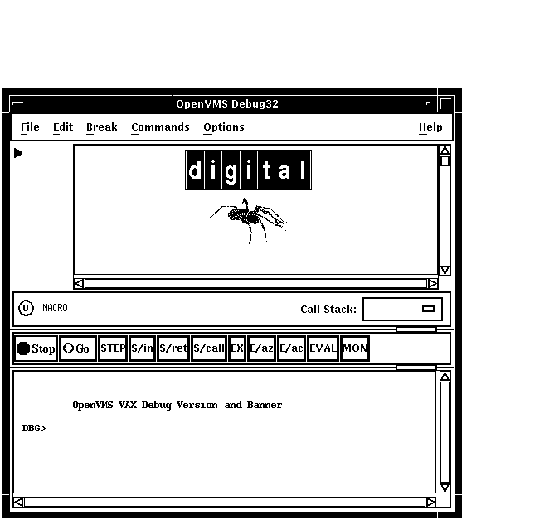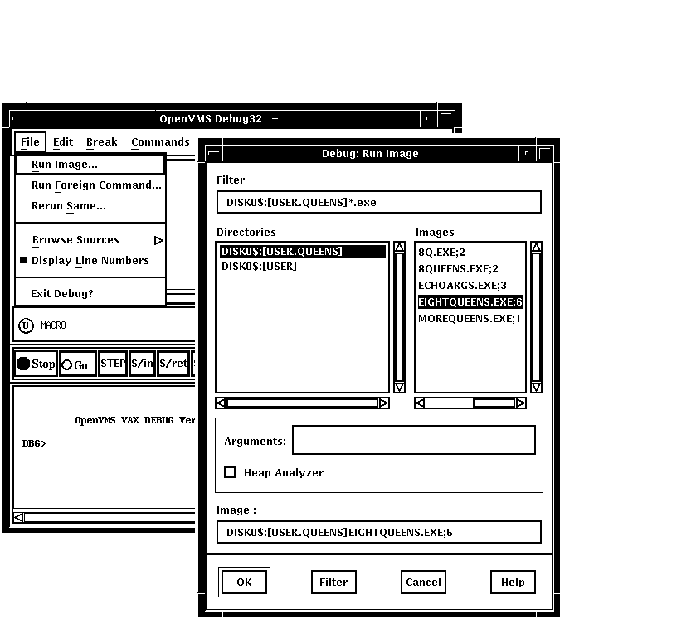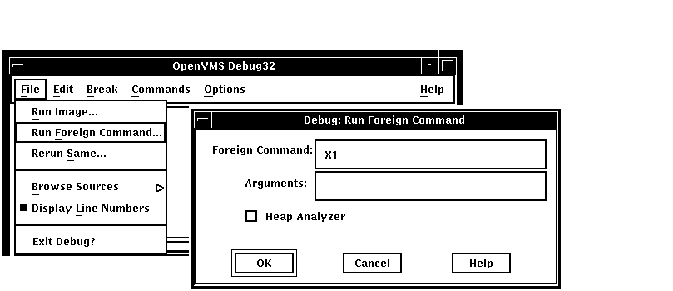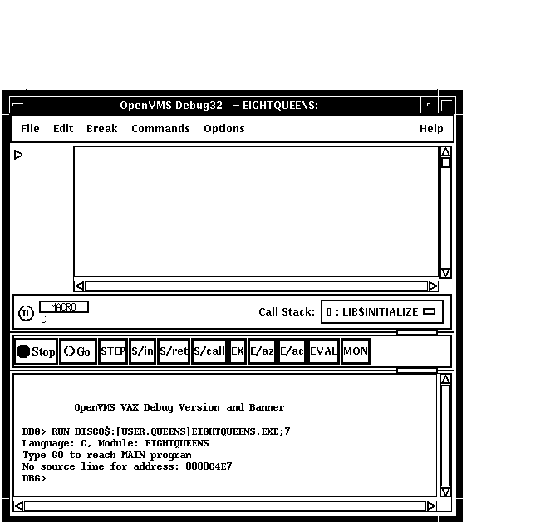![[Compaq]](../../images/compaq.gif)
![[Go to the documentation home page]](../../images/buttons/bn_site_home.gif)
![[How to order documentation]](../../images/buttons/bn_order_docs.gif)
![[Help on this site]](../../images/buttons/bn_site_help.gif)
![[How to contact us]](../../images/buttons/bn_comments.gif)
![[OpenVMS documentation]](../../images/ovmsdoc_sec_head.gif)
| Document revision date: 19 July 1999 | |
![[Compaq]](../../images/compaq.gif) |
![[Go to the documentation home page]](../../images/buttons/bn_site_home.gif)
![[How to order documentation]](../../images/buttons/bn_order_docs.gif)
![[Help on this site]](../../images/buttons/bn_site_help.gif)
![[How to contact us]](../../images/buttons/bn_comments.gif)
|
![[OpenVMS documentation]](../../images/ovmsdoc_sec_head.gif)
|
|
| Previous | Contents | Index |
This chapter explains how to:
This section explains the most common way to start the debugger from DCL level ($) and bring your program under debugger control. Section 9.7 explains optional ways to start the debugger.
Starting the kept debugger as explained here enables you to use the Rerun (see Section 9.3) and Run (see Section 9.4) features.
To start the debugger and bring your program under debugger control:
$ DEBUG/KEEP |
Figure 9-1 Debugger at Startup

Figure 9-2 Running a Program by Specifying an Image

$X1 :== RUN MYDISK:[MYDIR.MYSUBDIR]EIGHTQUEENS.EXE |
Figure 9-3 Running a Program by Specifying a Command Symbol

Once the debugger has control of the program, the debugger:
Figure 9-4 Source Display at Startup

The message displayed in the command view indicates that this debugging session is initialized for a C program and that the name of the source module is EIGHTQUEENS.
With certain programs, the debugger sets a temporary breakpoint to suspend program execution at the start of some initialization code, before the main program, and displays the following message:
Type GO to reach MAIN program No source line for address: nnnnnnnn |
With some of these programs (for example, Ada programs), the breakpoint enables you to debug the initialization code using full symbolic information. The initialization sets up language-dependent debugger parameters. These parameters control the way the debugger parses names and expressions, formats debugger output, and so on.
You can now debug your program as explained in Chapter 10.
Note the following restrictions about running a program under debugger control:
If you try to run a program that does not exist, or misspell the name of a program that does exist, the following error messages are displayed in the DECterm window, rather than in the command view:
%DCL-W-ACTIMAGE, error activating image -CLI-E-IMAGEFNF, image file not found |
To avoid this problem, make sure the Select an application to run field
in the File Selection popup contains a valid file specification.
9.2 When Your Program Completes Execution
When your program completes execution normally during a debugging session, the debugger issues the following message:
'Normal successful completion' |
You then have the following options:
When running the kept debugger (see Section 9.1), you can rerun the program currently under debugger control at any time during a debugging session.
To rerun the program:
Figure 9-5 Rerunning the Same Program

When you rerun a program, it is in the same initial state as a program that is brought under debugger control as explained in Section 9.1, except for any saved breakpoints, tracepoints, or static watchpoints. The source display and current location pointer are updated accordingly.
When you rerun a program, the debugger uses the same version of the
image that is currently under debugger control. To debug a different
version of that program (or a different program) from the same
debugging session, choose Run Image... or Run Foreign Command.. from
the File menu on the main window (see Section 9.1).
9.4 Running Another Program from the Current Debugging Session
You can bring another program under debugger control at any time during
a debugging session, if you started the debugger as explained in
Section 9.1. Follow the procedure in that section for bringing a
program under debugger control (also note the restrictions about using
that procedure).
9.5 Interrupting Program Execution and Aborting Debugger Operations
To interrupt program execution during a debugging session, click on the Stop button on the push button view (see Figure 8-3). This is useful if, for example, the program is in an infinite loop.
To abort a debugger operation in progress, click on Stop. This is useful if, for example, the debugger is displaying a long stream of data.
Clicking on Stop does not end the debugging session. Clicking on Stop
has no effect when the program is not running or when the debugger is
not executing a command.
9.6 Ending a Debugging Session
To end a debugging session and terminate the debugger, choose Exit Debugger from the File menu on the main window, or enter EXIT at the prompt (to avoid confirmation dialogue). This returns control to system level.
To rerun your program from the current debugging session, see Section 9.3.
To run another program from the current debugging session, see
Section 9.4.
9.7 Additional Options for Starting the Debugger
In addition to the startup procedure described in Section 9.1, the following options are available for starting the debugger from DCL level ($):
In all cases, before starting the debugger, verify that you have
compiled and linked the modules of your program (as explained in
Section 1.2) and established the proper debugging configuration (as
explained in Section 1.9).
9.7.1 Starting the Debugger by Running a Program
You can start the debugger and also bring your program under debugger control in one step by entering the DCL command RUN filespec (assuming the program was compiled and linked with the /DEBUG qualifier).
However, you cannot then use the Rerun or Run features explained in Section 9.3 and Section 9.4, respectively. To rerun the same program or run a new program under debugger control, you must first exit the debugger and start it again.
To start the debugger by running a program, enter the DCL command RUN filespec to start the debugger. For example:
$ RUN EIGHTQUEENS |
By default, the debugger starts up as shown in Figure 9-4, executing any user-defined initialization file and displaying the program's source code in the main window. The current-location pointer shows that execution is paused at the start of the main program. The debugger sets the language-dependent parameters to the source language of the main program unit.
For more information about debugger startup, see Section 9.1.
9.7.2 Starting the Debugger After Interrupting a Running Program
You can bring a program that is executing freely under debugger
control. This is useful if you suspect that the program might be in an
infinite loop or if you see erroneous output.
To bring your program under debugger control:
For example:
$ RUN/NODEBUG EIGHTQUEENS . . . [Ctrl/Y] Interrupt $ DEBUG [starts debugger] |
At startup, the debugger displays the main window and executes any user-defined initialization file, and sets the language-dependent parameters to the source language of the module in which execution was interrupted.
To help you determine where execution was interrupted:
When you start the debugger in this manner, you cannot then use the Rerun or Run features explained in Section 9.3 and Section 9.4, respectively. To rerun the same program or run a new program under debugger control, you must first exit the debugger and start it again.
For more information about debugger startup, see Section 9.1.
9.7.3 Overriding the Debugger's Default Interface
By default, if your workstation is running DECwindows Motif, the debugger starts up in the DECwindows Motif interface, which is displayed on the workstation specified by the DECwindows Motif applicationwide logical name DECW$DISPLAY.
This section explains how to override the debugger's default DECwindows Motif interface to achieve the following:
The logical name DBG$DECW$DISPLAY enables you to override the default interface of the debugger. In most cases, there is no need to define DBG$DECW$DISPLAY because the default is appropriate.
Section 9.7.3.4 provides more information about the logical names
DBG$DECW$DISPLAY and DECW$DISPLAY.
9.7.3.1 Displaying the Debugger's DECwindows Motif Interface on Another Workstation
If you are debugging a DECwindows Motif application that uses most of the screen (or if you are debugging pop-ups in a Motif application), you might find it useful to run the program on one workstation and display the debugger's DECwindows Motif interface on another. To do so:
DEFINE/JOB DBG$DECW$DISPLAY workstation_pathname |
To display the debugger's command interface in a DECterm window, along with any program I/O:
$ DEFINE/JOB DBG$DECW$DISPLAY " " |
For example:
$ DEFINE/JOB DBG$DECW$DISPLAY " "
$ DEBUG/KEEP
Debugger Banner and Version Number
DBG>
|
You can now bring your program under debugger control as explained in Section 9.1.
9.7.3.3 Displaying the Command Interface and Program Input/Output in Separate DECterm Windows
This section describes how to display the debugger's command interface
in a DECterm window other than the DECterm window in which you start
the debugger. This separate window is useful when using the command
interface to debug a screen-oriented program as follows:
The effect is the same as entering the SET MODE SEPARATE command at the DBG> prompt on a workstation running VWS rather than DECwindows Motif. (The SET MODE SEPARATE command is not valid when used in a DECterm window.)
The following example shows how to display the debugger's command interface in a separate debugger window titled Debugger.
| Example 9-1 Command Procedure SEPARATE_WINDOW.COM | |||
|---|---|---|---|
$ ! Simulates effect of SET MODE SEPARATE from a DECterm window
$ !
$ CREATE/TERMINAL/NOPROCESS -
/WINDOW_ATTRIBUTES=(TITLE="Debugger",-
ICON_NAME="Debugger",ROWS=40)-
/DEFINE_LOGICAL=(TABLE=LNM$JOB,DBG$INPUT,DBG$OUTPUT)
$ ALLOCATE DBG$OUTPUT
$ EXIT
$ !
$ ! The command CREATE/TERMINAL/NOPROCESS creates a DECterm
$ ! window without a process.
$ !
$ ! The /WINDOW_ATTRIBUTES qualifier specifies the window's
$ ! title (Debugger), icon name (Debugger), and the number
$ ! of rows in the window (40).
$ !
$ ! The /DEFINE_LOGICAL qualifier assigns the logical names
$ ! DBG$INPUT and DBG$OUTPUT to the window, so that it becomes
$ ! the debugger input and output device.
$ !
$ ! The command ALLOCATE DBG$OUTPUT causes the separate window
$ ! to remain open when you end the debugging session.
|
$ @SEPARATE_WINDOW %DCL-I-ALLOC, _MYNODE$TWA8: allocated |
$ DEASSIGN/JOB DBG$INPUT $ DEASSIGN/JOB DBG$OUTPUT |
By default, if your workstation is running DECwindows Motif, the debugger starts up in the DECwindows Motif interface, which is displayed on the workstation specified by the DECwindows Motif applicationwide logical name DECW$DISPLAY. DECW$DISPLAY is defined in the job table by FileView or DECterm and points to the display device for the workstation.
For information about DECW$DISPLAY, see the description of the DCL commands SET DISPLAY and SHOW DISPLAY in the OpenVMS DCL Dictionary.
The logical name DBG$DECW$DISPLAY is the debugger-specific equivalent of DECW$DISPLAY. DBG$DECW$DISPLAY is similar to the debugger-specific logical names DBG$INPUT and DBG$OUTPUT. These logical names enable you to reassign SYS$INPUT and SYS$OUTPUT, respectively, to specify the device on which debugger input and output are to appear.
The default user interface of the debugger results when DBG$DECW$DISPLAY is undefined or has the same translation as DECW$DISPLAY. By default, DBG$DECW$DISPLAY is undefined.
The algorithm that the debugger follows when using the logical definitions of DECW$DISPLAY and DBG$DECW$DISPLAY is as follows:
To enable the OpenVMS Debugger to start up in the DECwindows Motif interface, first enter one of the following DCL commands:
$DEFINE DBG$DECW$DISPLAY "WSNAME::0" $SET DISPLAY/CREATE/NODE=WSNAME |
where WSNAME is the nodename of your workstation.
| Previous | Next | Contents | Index |
![[Go to the documentation home page]](../../images/buttons/bn_site_home.gif)
![[How to order documentation]](../../images/buttons/bn_order_docs.gif)
![[Help on this site]](../../images/buttons/bn_site_help.gif)
![[How to contact us]](../../images/buttons/bn_comments.gif)
|
| privacy and legal statement | ||
| 4538PRO_019.HTML | ||